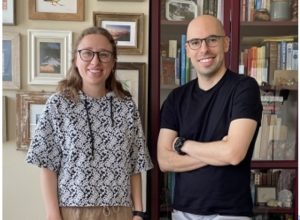|
Getting your Trinity Audio player ready...
|

(Photo courtesy of Defne Bayik, PhD)
Deadly brain tumors, called glioblastoma (GBM), are highly aggressive and treatment resistant, but researchers at Sylvester Comprehensive Cancer Center at the University of Miami Miller School of Medicine appear to be onto at least one of their tricks to survival, according to a preclinical study published in Nature Cancer.
Sylvester investigators and colleagues at multiple sites worldwide have shown that GBM cells recruit mitochondria from neural housekeeping cells called astrocytes. The additional mitochondria boost GBM cell metabolism and make the cancer cells more aggressive.
“These mitochondria transfers make tumor cells more metabolically active and proliferative and increase their capacity for self-renewal,” said Dr. Dionysios C. Watson, Sylvester researcher and co-first author on the paper. “This seems like a fundamental way glioblastoma becomes such a challenging cancer to treat, and if we understand the mechanism, we may be able to design better ways to stop it.”
GBMs are one of the deadliest cancers — the five-year survival rate is only 6.8 percent — and this mitochondrial transfer mechanism may contribute to that legacy. Like many cancers, GBMs find ways to co-opt neighboring cells to fuel their rapid growth and persistence. This study substantially increased scientists’ understanding of the profound impact that leaching mitochondria from neighboring cells in the tumor microenvironment has on the growth and aggressiveness of GBM.
The idea for the research originated when Watson and colleague Defne Bayik, PhD, an assistant professor at Sylvester and co-first author, saw a study that showed neurons can pull mitochondria from other cells after a stroke. They wondered if a similar mechanism might play a role in GBM.
In the study, the team found microtubes can connect GBM cells to astrocytes. These microtubes create an intercellular highway, allowing mitochondria, and probably other structures, to move back and forth. The researchers also identified a protein, called GAP43, that supports these mitochondrial transfers and could be a therapeutic target.
“We always want to translate our laboratory findings into potential treatments,” Bayik said.
“GAP43 plays a key role in this mitochondrial trafficking. If we could develop molecules that inhibit GAP43, we might be able to limit this mitochondrial transfer and that could potentially prolong survival.”
This group effort included researchers from Cleveland Clinic, Case Western Reserve University, University of Alabama at Birmingham, University of Michigan, University of Bordeaux and University of Bergen in Norway. Hrvoje Miletic, PhD, professor at the University of Bergen, and Justin Lathia, PhD, professor at Cleveland Clinic, were senior authors on the study.
“Dr. Miletic’s group saw our research and reached out to us with similar findings,” Watson said.
Because the two groups had complementary data, they combined their findings, and worked together to complete the comprehensive experiments of this study.
If these findings are supported in additional studies, the discovery could have a major impact on cancer research and, eventually, treatment. Although this study specifically focuses on GBM, the researchers say it is possible that similar mechanisms contribute to other cancers, potentially opening new therapeutic development avenues in many tumor types. In addition, researchers at Sylvester and other cancer centers will continue to dissect the mechanisms associated with mitochondrial transfer in GBM.
“We are actively working to find other proteins, beyond GAP43, that are also involved in the transfer,” Bayik said. “We also want to understand how these transfers drive molecular changes in GBM cells. What is actually making these cells more tumorigenic? That will give us even more insights into this mechanism and hopefully more treatment targets.”
ABOUT US:
For more Miami community news, look no further than Miami Community Newspapers. This Miami online group of newspapers covers a variety of topics about the local community and beyond. Miami’s Community Newspapers offers daily news, online resources, podcasts and other multimedia content to keep readers informed. With topics ranging from local news to community events, Miami’s Community Newspapers is the ideal source for staying up to date with the latest news and happenings in the area. Additionally, the newspaper has exclusive Miami community podcasts, providing listeners with an in-depth look into Miami’s culture. Whether you’re looking for local Miami news, or podcasts about the community, Miami’s Community Newspapers has you covered.





